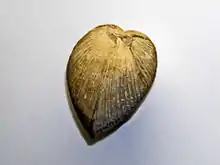Pholadomya
Pholadomya is a genus of saltwater clams, marine bivalve molluscs in the family Pholadomyidae.
| Pholadomya | |
|---|---|
 | |
| Fossil specimen of Pholadomya scutata species from Jurassic deposits | |
| Scientific classification | |
| Domain: | Eukaryota |
| Kingdom: | Animalia |
| Phylum: | Mollusca |
| Class: | Bivalvia |
| Subterclass: | Heterodonta |
| Family: | Pholadomyidae |
| Genus: | Pholadomya G. B. Sowerby I, 1823 |
| Type species | |
| Pholadomya candida G. B. Sowerby I, 1823 | |
| Species | |
|
See text | |
Distribution
Fossils species within this genus lived during the Mesozoic era, in the opening South Atlantic, between present-day Brazil and Africa. In the Triassic of Argentina, Austria, Hungary and Italy fossils have been found. They are found in the Jurassic of the Coquina Group, La Guajira, Colombia among many other places. Of Campanian age, this genus is widespread as a fossil in Cameroon, France, Poland, Austria, Germany and the United States. Fossils up to the Neogene have been found in Belgium, the United Kingdom, and Venezuela (Pliocene Mare and Playa Grande Formations) and Miocene Bulgaria, Chile, Colombia, Cyprus, Germany, India, Japan, Malta, Moldova, New Zealand, Panama, Poland, Russia, Slovakia, Trinidad and Tobago and Venezuela.[1] Today, only a single species, P. candida from the Caribbean is known to be extant.[2][3]
Species
Species within the genus Pholadomya include:[4]
- Pholadomya candida Sowerby, 1823
- †Pholadomya maoria Dell, 1963
- †Pholadomya scutata
- †Pholadomya tumida
- †Pholadomya triquetra
- †Pholadomya texta
References
- Pholadomya at Fossilworks.org
- DÍaz, Juan Manuel; Borrero, Francisco J. (1995). "On the occurrence of Pholadomya Candida Sowerby, 1823 (Bivalvia: Anomalodesmata) on the Caribbean Coast of Colombia". Journal of Molluscan Studies. 61 (3): 407–408. doi:10.1093/mollus/61.3.407. ISSN 0260-1230.
- Diaz, Juan M.; Gast, Fernando; Torres, Diana C. (2009). "Rediscovery of a Caribbean living fossil: Pholadomya candida GB Sowerby I, 1823 (Bivalvia: Anomalodesmata: Pholadomyoidea)". The Nautilus. 123: 19–20.
- Illustrations conchyliologiques ou description et figures de toutes les coquilles connues vivantes et fossiles
External links
- WoRMS
- Encyclopaedia of Life
- GBIF
- Natalia Pereira Benaim & Maria Célia Elias Senra Gênero Pholadomya Sowerby, 1823 (Mollusca: Bivalvia) na Formação Jandaíra (Cretáceo Superior)